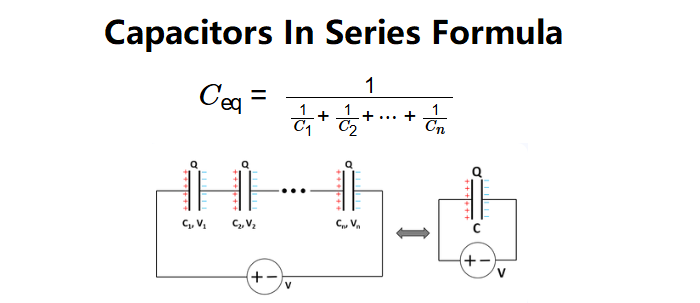1. What is Capacitors in Series Calculator?
Definition: This calculator computes the equivalent capacitance (\( C_{\text{eq}} \)) of multiple capacitors connected in series.
Purpose: It is used in electronics to determine the total capacitance in a series circuit, which is essential for designing filters, timing circuits, and other applications involving capacitors.
2. How Does the Calculator Work?
The calculator uses the formula for capacitors in series:
- \( \frac{1}{C_{\text{eq}}} = \frac{1}{C_1} + \frac{1}{C_2} + \cdots + \frac{1}{C_n} \)
- \( C_{\text{eq}} = \frac{1}{\frac{1}{C_1} + \frac{1}{C_2} + \cdots + \frac{1}{C_n}} \)
Where:
- \( C_{\text{eq}} \): Equivalent capacitance (F)
- \( C_1, C_2, \ldots, C_n \): Capacitance of each capacitor (F)
Steps:
- Select the number of capacitors.
- Enter the capacitance values for each capacitor with their units.
- Convert all inputs to farads (F).
- Calculate the sum of the inverses of the capacitances.
- Compute the equivalent capacitance by taking the inverse of the sum.
- Convert the result to the selected output unit.
- Display the result with 4 decimal places.
3. Importance of Capacitors in Series Calculation
Calculating the equivalent capacitance of capacitors in series is crucial for:
- Circuit Design: Determining the total capacitance in series circuits used in filters, timing circuits, or voltage dividers.
- Component Selection: Choosing appropriate capacitors to achieve the desired total capacitance.
- Voltage Distribution: Understanding how voltage is distributed across capacitors in series, as the total voltage is the sum of the voltages across each capacitor.
4. Using the Calculator
Example 1: Calculate the equivalent capacitance of four capacitors in series with \( C_1 = 2 \, \text{mF} \), \( C_2 = 5 \, \mu\text{F} \), \( C_3 = 6 \, \mu\text{F} \), and \( C_4 = 200 \, \text{nF} \):
- Capacitance Values:
- \( C_1 = 2 \, \text{mF} = 2 \times 10^{-3} \, \text{F} \)
- \( C_2 = 5 \, \mu\text{F} = 5 \times 10^{-6} \, \text{F} \)
- \( C_3 = 6 \, \mu\text{F} = 6 \times 10^{-6} \, \text{F} \)
- \( C_4 = 200 \, \text{nF} = 200 \times 10^{-9} = 2 \times 10^{-7} \, \text{F} \)
- Sum of inverses: \( \frac{1}{C_{\text{eq}}} = \frac{1}{2 \times 10^{-3}} + \frac{1}{5 \times 10^{-6}} + \frac{1}{6 \times 10^{-6}} + \frac{1}{2 \times 10^{-7}} \)
- \( \frac{1}{C_{\text{eq}}} = 500 + 200000 + 166666.67 + 5000000 = 5367166.67 \, \text{F}^{-1} \)
- Equivalent capacitance: \( C_{\text{eq}} = \frac{1}{5367166.67} \approx 1.863 \times 10^{-7} \, \text{F} = 0.1863 \, \mu\text{F} \)
- Result: \( C_{\text{eq}} = 0.1863 \, \mu\text{F} \)
Example 2: Calculate the equivalent capacitance of two capacitors in series with \( C_1 = 10 \, \mu\text{F} \) and \( C_2 = 20 \, \mu\text{F} \):
- Capacitance Values:
- \( C_1 = 10 \, \mu\text{F} = 10 \times 10^{-6} \, \text{F} \)
- \( C_2 = 20 \, \mu\text{F} = 20 \times 10^{-6} \, \text{F} \)
- Sum of inverses: \( \frac{1}{C_{\text{eq}}} = \frac{1}{10 \times 10^{-6}} + \frac{1}{20 \times 10^{-6}} \)
- \( \frac{1}{C_{\text{eq}}} = 100000 + 50000 = 150000 \, \text{F}^{-1} \)
- Equivalent capacitance: \( C_{\text{eq}} = \frac{1}{150000} \approx 6.6667 \times 10^{-6} \, \text{F} = 6.6667 \, \mu\text{F} \)
- Result: \( C_{\text{eq}} = 6.6667 \, \mu\text{F} \)
5. Frequently Asked Questions (FAQ)
Q: Why is the equivalent capacitance in series less than the smallest individual capacitance?
A: In a series connection, the inverse of the equivalent capacitance is the sum of the inverses of the individual capacitances, which results in a smaller total capacitance. This reflects the fact that the effective charge storage capacity is reduced.
Q: How does voltage distribute across capacitors in series?
A: The total voltage across the series combination is the sum of the voltages across each capacitor. The voltage across each capacitor is inversely proportional to its capacitance: \( V_i = \frac{Q}{C_i} \), where \( Q \) is the same for all capacitors in series.
Q: Can I use this calculator for capacitors in parallel?
A: No, this calculator is specifically for capacitors in series. For capacitors in parallel, the equivalent capacitance is the sum of the individual capacitances: \( C_{\text{eq}} = C_1 + C_2 + \cdots + C_n \).
Capacitors in Series Calculator© - All Rights Reserved 2025
 Home
Home
 Back
Back
